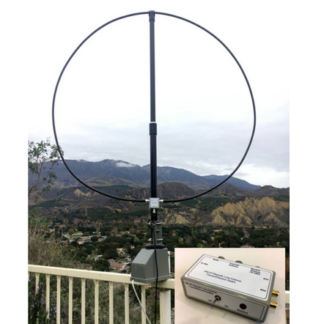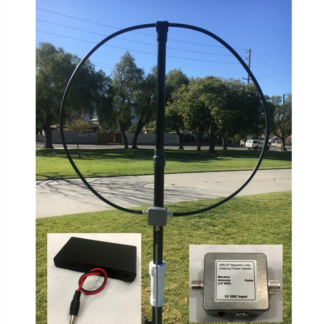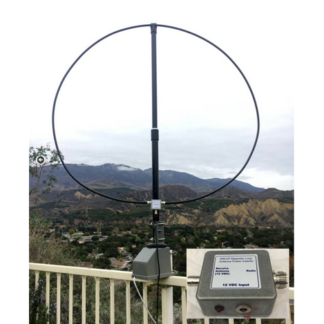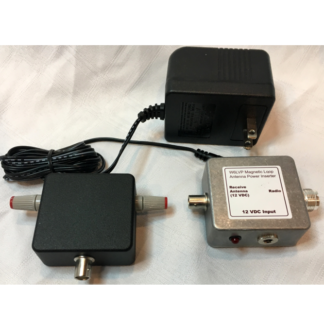Description
ABOUT THE PRODUCT
Increased man-made noise, the timing of the sunspot cycle, and other factors have conspired to make HF radio communications more challenging. Adding a power amplifier and increasing transmit power will help with a transmit signal. Reducing noise, RFI, QRN, and QRM during receive is more difficult. Thousands of amateurs and SWLs worldwide have improved the quality of their radio reception using a receive-only amplified magnetic loop antenna from me or my competitors. Now those benefits are available to experimenters and DIY builders wanting to construct their own loop and support structure.
This kit combined with readily available wire, PVC, copper tubing, or other construction materials available at your local hardware store, Lowes, or Home Depot enables easy construction of a cost-effective, high-performance amplified untuned receive loop. Hundreds of users worldwide are getting great reception and noise reduction results with the W6LVP. This kit uses the exact same electronics components – loop preamp, power inserter bias-T, and 120 volt AC to 12 volt DC linear low-noise power supply. With a little personal creativity and ingenuity, a DIY builder can enjoy the benefits of the W6LVP magnetic loop antenna at a significant savings.
I used an antenna like this for a couple of weeks on a Los Angeles to Hawaii and back cruise. It worked great either when located on the balcony or inside our stateroom close to a big window.
If you are a ham and your transceiver does not have a separate receive antenna input or if you need custom installation or construction suggestions, please reach out to me via CONTACT regarding these or any other questions.
W6LVP magnetic loop antenna experimenter kit features and benefits:
- The W6LVP includes all of the electronics – just add wire, tubing, or any other appropriate material for a loop with size of your choosing. A six-foot length of wire makes a great loop. If it is not stiff enough to support its own weight, put the preamp on the top and let gravity help.
- Use any non conductive material such as wood, bamboo, or PVC pipe to build a support structure for your antenna.
- The experimenter’s kit includes a low-noise, broadband amplifier covering 2200 (135 kHz) through 10 meters (30 MHz) with no tuning or adjustment.
- The W6LVP magnetic loop antenna experimenter’s kit includes a power inserter bias-T which enables the coaxial cable running to the antenna to carry radio signals from the antenna and 12 volts DC to power the loop preamp. The power inserter has reverse polarity and short circuit protection using a resettable solid-state fuse.
- The experimenter kit includes a 120 volt AC to 12 volt DC linear power supply to ensure that switching power supply noise is not added to your received signal..
I have received many requests for suggestions on which type of coaxial cable to use to connect the loop to the power inserter or T/R switch. When connecting a transmitter to an antenna, cable loss is very important. For connecting a receiver to a receive antenna, common mode pickup on the coaxial cable shield can add unwanted signals and noise. Quad-shield RG-6, which is designed for cable and satellite TV, works well but is normally sold with F connectors installed. Quad shield RG-6 cables can be purchased from MPD Digital in custom lengths with male BNC connectors installed.












Ralph Adams –
I purchased the experimenter’s kit last summer. I should point out that I am not a amateur radio operator and my interest was in getting back into SWL after several decades and had discovered that my old wire antenna could no longer receive much. After some research I decided on a magnetic loop as my best hope and the W6LVP experimenter’s kit due to its low cost; I had my doubts that SWL was a viable pastime anymore.
The antenna has changed all that. Within a few minutes of receiving it I had rigged up a 3 foot diameter loop using 10 gauge copper wire I had lying around, and I could once again bring in stations from Europe on the broadcast bands, and hams all up and down Western North America. I could not be happier with the results.
Also, the support from Larry was amazing. As I said, I am not a ham and do not have that much expertise in RF and antennas. Larry checked my location and within hours had got back to suggest suitable filters to deal with a large AM station a few kilometres away. Given that I was only using it for shortwave listening, he also suggested, and built, filters to keep out VHF and above.
Since then I have added a SDRplay receiver to my old Sony portable, and started studying for my amateur radio exams. All because of this amazing little antenna and Larry’s patience and advice.